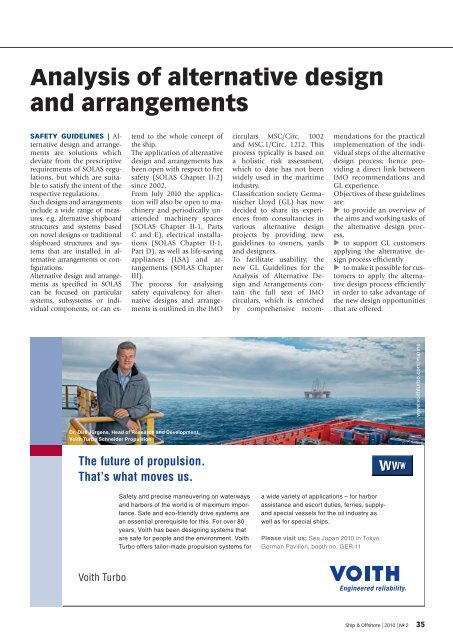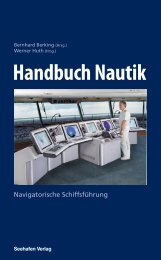| 2 | 2010 - Schiff & Hafen
| 2 | 2010 - Schiff & Hafen
| 2 | 2010 - Schiff & Hafen
You also want an ePaper? Increase the reach of your titles
YUMPU automatically turns print PDFs into web optimized ePapers that Google loves.
Analysis of alternative design<br />
and arrangements<br />
SAFETY GUIDELINES | Alternative<br />
design and arrangements<br />
are solutions which<br />
deviate from the prescriptive<br />
requirements of SOLAS regulations,<br />
but which are suitable<br />
to satisfy the intent of the<br />
respective regulations.<br />
Such designs and arrangements<br />
include a wide range of measures,<br />
e.g. alternative shipboard<br />
structures and systems based<br />
on novel designs or traditional<br />
shipboard structures and systems<br />
that are installed in alternative<br />
arrangements or confi<br />
gurations.<br />
Alternative design and arrangements<br />
as specifi ed in SOLAS<br />
can be focused on particular<br />
systems, subsystems or individual<br />
components, or can ex-<br />
tend to the whole concept of<br />
the ship.<br />
The application of alternative<br />
design and arrangements has<br />
been open with respect to fi re<br />
safety (SOLAS Chapter II-2)<br />
since 2002.<br />
From July <strong>2010</strong> the application<br />
will also be open to machinery<br />
and periodically unattended<br />
machinery spaces<br />
(SOLAS Chapter II-1, Parts<br />
C and E), electrical installations<br />
(SOLAS Chapter II-1,<br />
Part D), as well as life-saving<br />
appliances (LSA) and arrangements<br />
(SOLAS Chapter<br />
III).<br />
The process for analysing<br />
safety equivalency for alternative<br />
designs and arrangements<br />
is outlined in the IMO<br />
circulars MSC/Circ. 1002<br />
and MSC.1/Circ. 1212. This<br />
process typically is based on<br />
a holistic risk assessment,<br />
which to date has not been<br />
widely used in the maritime<br />
in dustry.<br />
Classifi cation society Germanischer<br />
Lloyd (GL) has now<br />
decided to share its experiences<br />
from consultancies in<br />
various alternative design<br />
projects by providing new<br />
guidelines to owners, yards<br />
and designers.<br />
To facilitate usability, the<br />
new GL Guidelines for the<br />
Analysis of Alternative Design<br />
and Arrangements contain<br />
the full text of IMO<br />
circulars, which is enriched<br />
by comprehensive recom-<br />
mendations for the practical<br />
implementation of the individual<br />
steps of the alternative<br />
design process; hence providing<br />
a direct link between<br />
IMO recommendations and<br />
GL experience.<br />
Objectives of these guidelines<br />
are:<br />
�<br />
to provide an overview of<br />
the aims and working tasks of<br />
the alternative design process,<br />
� to support GL customers<br />
applying the alternative design<br />
process effi ciently<br />
�<br />
to make it possible for cus-<br />
tomers to apply the alternative<br />
design process effi ciently<br />
in order to take advantage of<br />
the new design opportunities<br />
that are offered.<br />
Ship & Offshore | <strong>2010</strong> | N o 2 35



